The digital forecast: 40-plus cloud computing stats and trends to know in 2023

Blair Franklin
Contributing Writer, Google Cloud
Stay in the know and spark dialogue with the latest cloud computing insights from our live blog. Bonus: Every stat has a grab-and-go slide.
How are IT leaders changing their cloud strategies in times of uncertainty? What are the biggest barriers to achieving true corporate sustainability? What’s helping to reduce burnout on software and IT teams? Where does Vint Cerf get all of his stylish pocket squares? (We're still gathering data on that last one.)
The cloud computing landscape is as dynamic as the weather. As the pace of innovation in the cloud and the availability of new tools and services continues to explode, Gartner® forecasts worldwide public cloud end-user spending to reach nearly $600 billion in 2023. It’s an exciting, promising, and sometimes dizzying space.
To help the C-suite, IT, and business decision-makers keep up with industry-shaping trends, we’re kicking off this live blog to share the latest insights across topics that matter to today’s organizational leaders: business resilience, data analytics, artificial intelligence (AI) and machine learning (ML), cloud infrastructure, cybersecurity, corporate sustainability, and more.
Bonus: Every stat has a complementary visual slide available to download. We’ll be adding to this post each week, so bookmark it as a go-to resource for the latest cloud computing trends, statistics, and insights to shape decision-making in 2023.
Explore by category — new topics will be added regularly:
Financial resilience stats
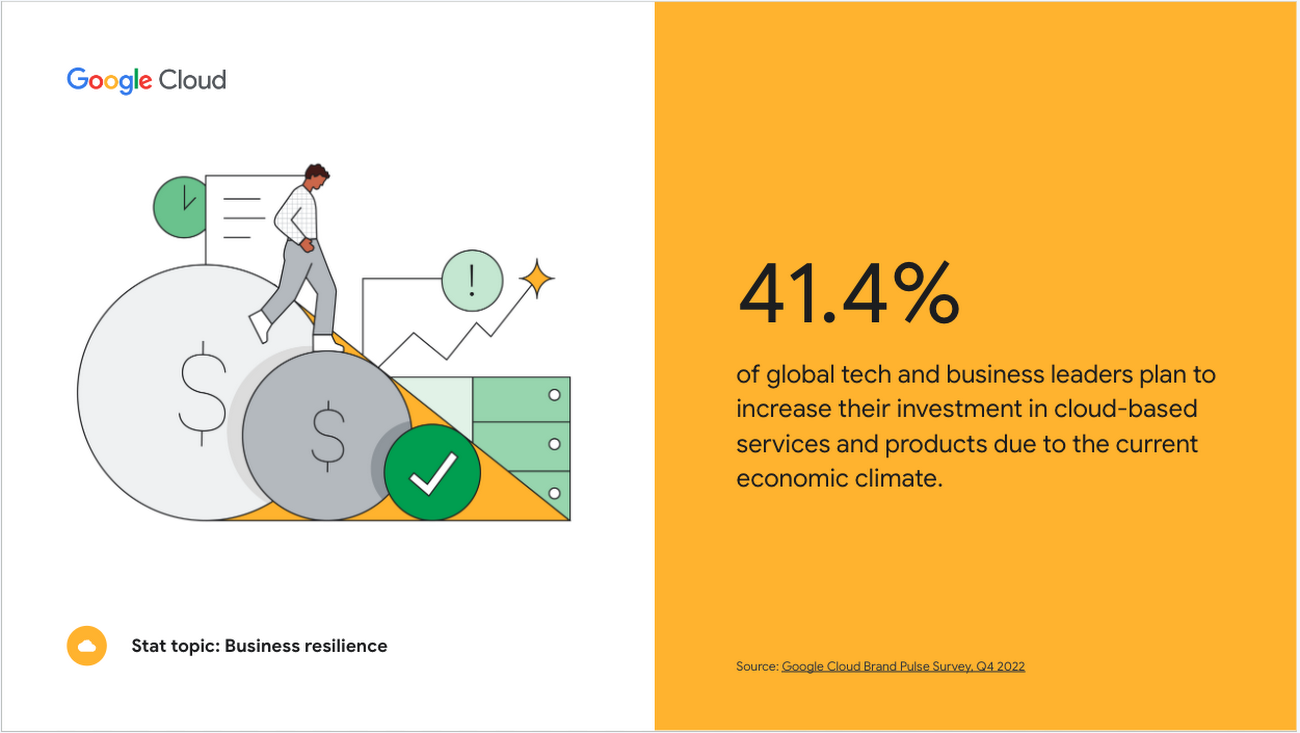

1. IT leaders are looking to the cloud to help prepare for whatever lies ahead.
Due to the current macroeconomic climate, cloud leaders say they are increasing their use of cloud-based services and products (41.4%), planning to migrate from legacy enterprise software to cloud-based tools (33.4%), and migrating on-premises workloads to the cloud (32.8%). Download slide Source: Google Cloud Brand Pulse Survey, Q4 2022. Learn more about how decision-makers are preparing for uncertainty.
2. Cloud decision-makers are prioritizing staffing efforts when it comes to cloud cost optimization.
More than half of organizations are either hiring new staff or re-training existing staff to better optimize their cloud spend. Download slide Source: Forrester, 2022 Infrastructure Cloud Survey
3. Most companies have yet to embrace cloud FinOps.
In a 2022 survey of cloud FinOps practitioners, 37.1% of the 572 respondents who answered a question about the maturity level of their cloud FinOps efforts said they were in the “crawl” stage — getting the basics in place. Another 41.7% were in the “walk” stage, where practitioners have established practices but not yet perfected them, while just 19.5% of participants were at the leading edge of maturity, where cloud FinOps is business as usual (the “run” stage). The remaining respondents comprised a “pre-crawl” segment. Download slide Source: The State of FinOps 2022, FinOps Foundation. Learn more about harnessing the power of FinOps.
4. Companies in every industry can capture substantial value from cloud.
A detailed review of cloud cost-optimization levers and value-oriented business use cases foresees more than $1 trillion in run-rate EBITDA across Fortune 500 companies as up for grabs in 2030. Download slide Source: Cloud’s trillion-dollar prize is up for grabs, McKinsey, 2021
5. “Industry clouds” will increase organizational agility, speed innovation, and accelerate time to value.
By 2027, more than 50% of enterprises will use industry cloud platforms to accelerate their business initiatives. Industry cloud platforms enable a shift from generic solutions to platforms designed to fit the specifics of the user’s industry. Download slide Source: Gartner® ebook, Gartner's 2023 Top Strategic Technology Trends, 2022. GARTNER is a registered trademark and service mark of Gartner, Inc. and/or its affiliates in the U.S. and internationally and is used herein with permission. All rights reserved.
6. Automated cloud cost optimization policies can save time and reduce wasted spend.
More than 40% of technical and business professionals are using automated policies to shut down workloads after hours and to rightsize underutilized instances. Automated cloud cost optimization policies can save time while ensuring organizations monitor their environments consistently to eliminate waste. Download slide Source: Flexera 2022 State of the Cloud Report
7. When it comes to a strategic cloud computing partner, decision-makers are looking for three specific characteristics.
The majority (54%) of global tech and business leaders want a cloud service provider who helps them identify technology strategies to increase revenue or reduce costs. Further, 50% define a “strategic partner” as one who “understands where my industry is going and has solutions for future needs,” and 50% say it’s “having a services organization that helps implement and maintain my infrastructure.” Download slide Source: Internal data from the Google Cloud Brand Pulse Survey, Q3 2022
Artificial intelligence (AI) and machine learning (ML) stats
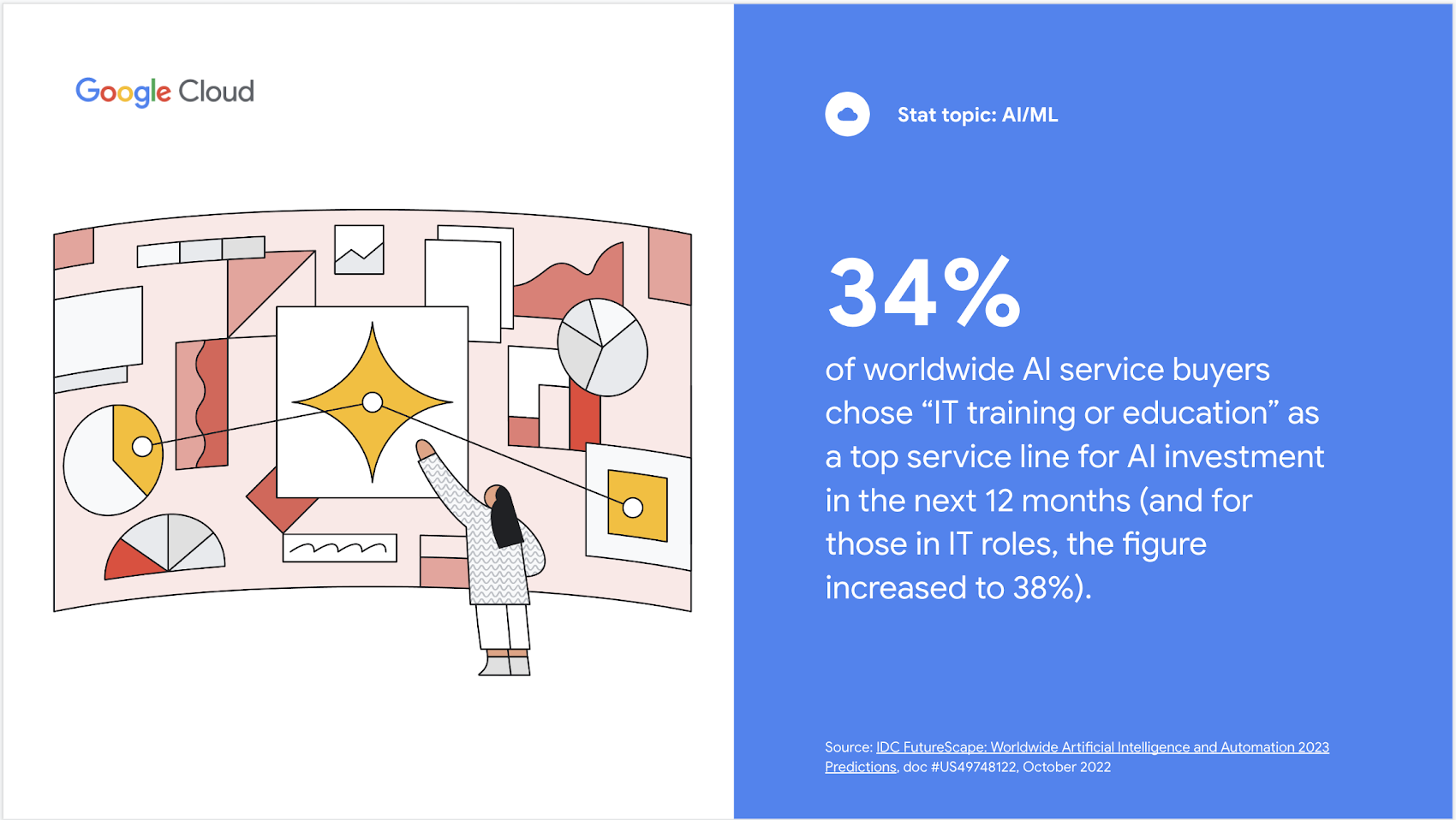

1. Get ready to reskill rather than just hiring new employees for AI skills.
IDC research suggests organizations realize they can’t simply hire data scientists to solve AI talent issues and will invest internally in reskilling and AI-enabled augmentation of existing employees. Some 34% of worldwide AI service buyers chose “IT training or education” as a top service line for AI investment in the next 12 months (and for those in IT roles, the figure increased to 38%). Download slide Source: IDC FutureScape: Worldwide Artificial Intelligence and Automation 2023 Predictions, doc #US49748122, October 2022
2. AI/ML is a top workload requirement driving multicloud deployments.
Today’s tech leaders need cloud infrastructure that can support AI/ML workloads, and they’ll use other cloud providers beyond their primary cloud provider to get what they need. According to Enterprise Strategy Group research, 39% cite AI/ML as a top workload and/or workload requirement leading to their use of other cloud providers in addition to their primary cloud provider. Application development and testing (39%), database clustering (33%), and global service delivery (31%) are some other top requirements. Download slide. Source: Enterprise Strategy Group eBook, Multicloud Application Deployment & Delivery Decision Making, February 2023
3. AI and computing advancements are helping to scale digital transformation and propel AI towards mainstream adoption.
As AI adoption ramps up and the pressure to keep pace with demand for AI-based services and tools increases, most organizations will use codeless development tools for at least 30% of AI and automation initiatives by 2024. Download slide Source: IDC FutureScape: Worldwide Artificial Intelligence and Automation 2023 Predictions, doc #US49748122, October 2022
4. AI is finding its way into every layer of technology that organizations use to help drive automation.
By 2026, AI-driven features will be embedded across business technology categories with 60% of organizations using them to drive better outcomes without relying on technical AI talent. Download slide Source: IDC FutureScape: Worldwide Artificial Intelligence and Automation 2023 Predictions, doc #US49748122, October 2022
5. AI has the potential to help organizations and people to be more productive.
Trends show that by 2026, 85% of enterprises will combine human expertise with AI, ML, natural language processing (NLP), and pattern recognition to help augment foresight, increasing worker productivity by 25%. Download slide Source: IDC FutureScape: Worldwide Artificial Intelligence and Automation 2022 Predictions, doc #US48298421, October 2021
6. Organizations have not reached a level of maturity in their AI infrastructure.
When it comes to AI/ML initiatives, survey results from the International Data Corporation (IDC) show that most organizations are still in the experimentation, evaluation and testing, or prototyping phases. Only 31% of respondents said they had AI in production — and just a third from that segment claimed to have reached a mature state of adoption, where the entire organization benefits from an enterprise-wide AI strategy. Download slide Source: IDC Press Release, IDC Survey Illustrates the Growing Importance of Purpose-built AI Infrastructure in the Modern Enterprise, February 2022. Read more: Build an effective AI strategy: Overcome four common adoption challenges
7. CxOs are leveraging AI to turn IT operations into a well-oiled machine.
Nearly 40% of decision-makers are using AI to improve efficiencies in IT operations. CxOs also indicated this is their most common use case for AI. Download slide Source: Forrester 2022 Data & Analytics survey
8. Adaptive AI accelerates value and continuously keeps AI aligned to enterprise goals in real time.
By 2026, enterprises that have adopted AI engineering practices to build and manage adaptive AI systems will outperform their peers in the operationalizing AI models by at least 25%. Adaptive AI systems use real-time feedback to learn dynamically and adjust, even for unforeseen real-world changes. Download slide Source: Gartner® ebook, Gartner's 2023 Top Strategic Technology Trends, 2022. GARTNER is a registered trademark and service mark of Gartner, Inc. and/or its affiliates in the U.S. and internationally and is used herein with permission. All rights reserved.
Culture of innovation stats
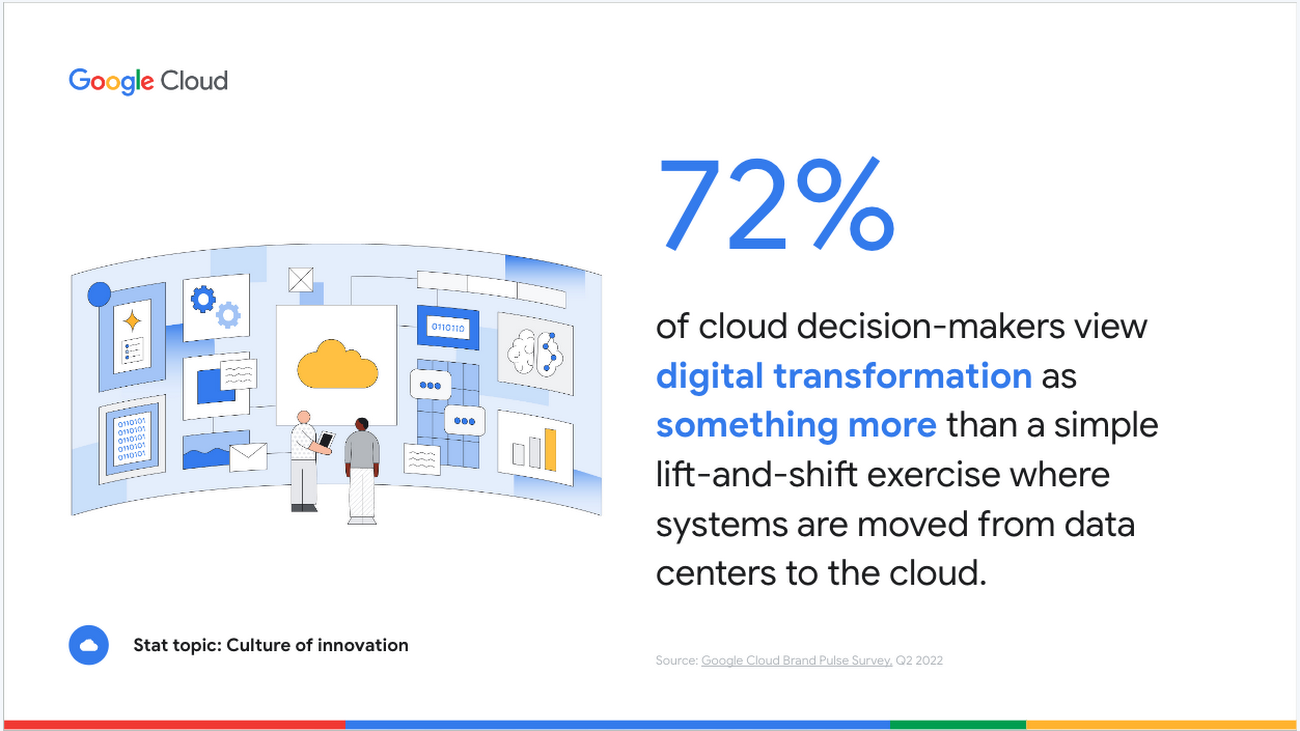

Source: Google Cloud Brand Pulse Survey, Q4 2022. Download the slide or read the full article.
1. The meaning of digital transformation is changing.
72% of cloud decision-makers view digital transformation as something more than a simple lift-and-shift exercise where systems are moved from data centers to the cloud. Download slide Source: Google Cloud Brand Pulse Survey, Q2 2022. Read more about how the definition of digital transformation is changing.
2. Organizations plan to focus on investments towards innovation over the next five years.
Some 75% of enterprises plan to invest in new technology platforms to facilitate innovation exchange. Other significant areas include investing in additional training programs on innovation (64%), evolving hiring policies to capture more diverse ideas and approaches (53%), and strengthening data gathering and analysis processes to support decision making (42%). Download slide Source: Create a Culture of Innovation, Google Cloud, 2022
3. Process optimization and customer experience are at the heart of digital transformations.
Around 47% of cloud decision-makers say digital transformation means optimizing processes and becoming more operationally agile, and another 40% say it’s improving customer experience. Download slide and bonus gif Source: Google Cloud Brand Pulse Survey, Q2 2022. Read more about how business leaders define digital transformation.
4. Culture has a significant effect on whether individuals struggle with burnout as a result of working remotely.
Teams with a generative culture, composed of people who felt included and like they belonged on their team, were half as likely to experience burnout during the pandemic. This finding reinforces the importance of prioritizing team and culture. Teams that do better are equipped to weather more challenging periods that put pressure on both the team and on individuals. Download slide Source: 2021 State of DevOps Report, commissioned by the Google Cloud DORA Team
5. The experiences of diverse employees are leading to poor outcomes for individuals and employers.
50% of employees are estimated to have left a job due to DEI shortcomings. Download slide Source: "It’s Time to Reimagine Diversity, Equity, and Inclusion," Boston Consulting Group, May 2021
6. The use of cloud computing has a positive impact on overall organizational performance.
IT leaders and practitioners that use cloud computing are 14% more likely to exceed organizational performance goals than peers that do not. Download slide Source: 2022 State of DevOps Report, commissioned by the Google Cloud DORA Team
Cloud infrastructure stats
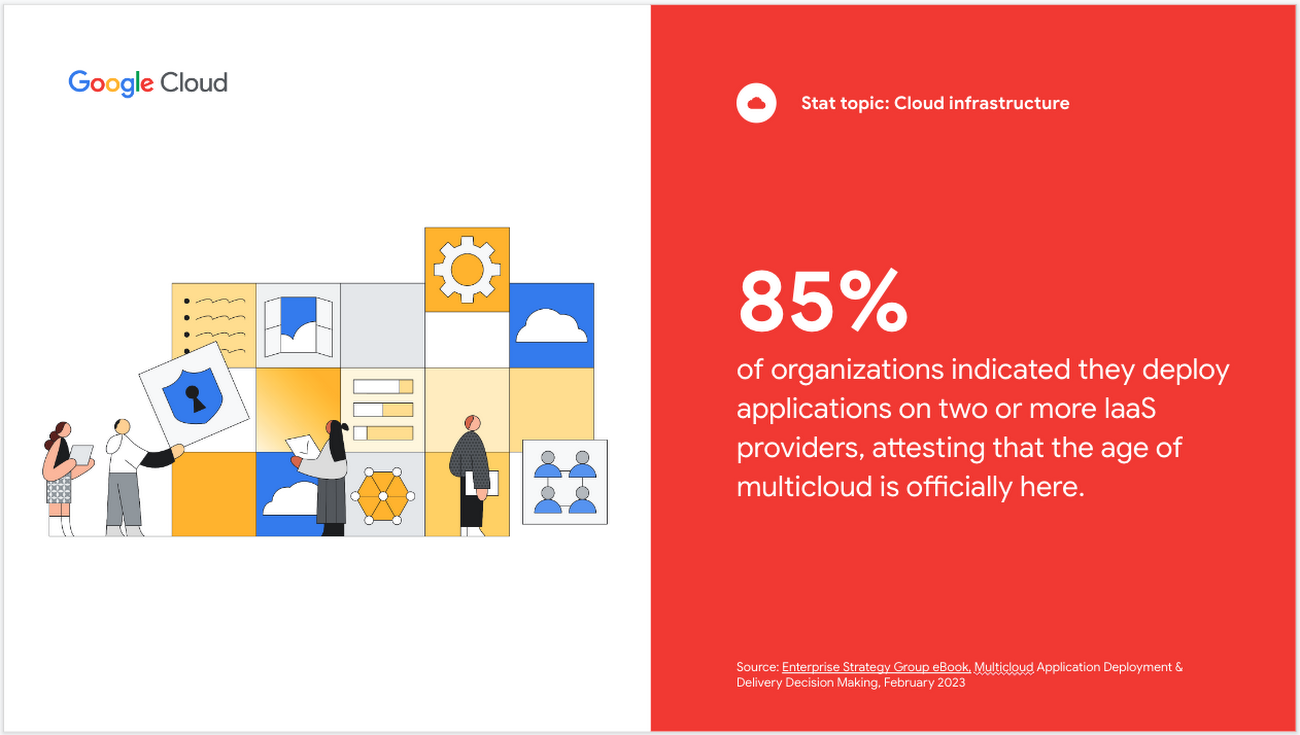

1. Leading IT professionals embrace multicloud. In order to scale applications to meet the needs of their users, more and more organizations are managing their resources in distributed application environments.
According to a recent survey by Enterprise Strategy Group, the majority of organizations deploy applications in 2+ on-premises data centers, 2+ colocation providers, 3+ IaaS providers, and 3+ PaaS providers. The age of multicloud is officially here, as 85% of organizations indicated they deploy applications on two or more IaaS providers. Download slide Source: Enterprise Strategy Group eBook, Multicloud Application Deployment & Delivery Decision Making, February 2023
2. When it comes to selecting the right cloud provider, more groups are getting a seat at the table.
For many, choosing a cloud provider used to be the sole responsibility of the IT department. But today, it is a highly strategic decision involving multiple members across IT, information security, the C-suite, and more. On average, 3.7 groups in an organization own cloud selection decisions. The top groups cited that have decision-making authority are IT Leadership (50%), Information Security, (47%), IT Infrastructure and Management (47%), and non-IT Executive Management/C-suite (44%). Download slide Source: Enterprise Strategy Group eBook, Multicloud Application Deployment & Delivery Decision Making, February 2023
3. Cloud-first is the dominant policy for deploying new applications.
Across deployment strategies for net-new applications and workloads, 47% of organizations within various industries follow a cloud-first strategy by deploying new applications using public cloud services. Meanwhile, 27% of organizations consider both public cloud services and on-premises resources for new applications, while 26% are on-premises-first but still consider compelling cases to deploy in cloud. Download slide Source: Enterprise Strategy Group eBook, Multicloud Application Deployment & Delivery Decision Making, February 2023
4. The desire for flexibility fuels multicloud decision making, and the type of desired flexibility varies by industry.
Performance flexibility (35%) is the top cited reason for using more than one public cloud infrastructure provider. Industry also plays a role in what type of prioritization IT leaders care about. For example, healthcare organizations (45%) lean more heavily towards cost flexibility. Retail (48%) and technology (45%) organizations want teams to be able to use their preferred clouds of choice. Finance organizations (43%) want to avoid vendor lock-in. Download slide Source: Enterprise Strategy Group eBook, Multicloud Application Deployment & Delivery Decision Making, February 2023
5. Organizations are doubling down on cloud and hybrid cloud, pushing even more applications out of on-premises environments.
In 2022, 93% of technology leaders said they were “mostly cloud” in some form — up from 83% two years ago — and 48% said they were “mostly hybrid,” up from 40% two years ago. Meanwhile, the number of respondents who said they were “mostly on-premises'' dropped by half to 7%. Download slide Source: 2022 State of APIs and Applications
6. IT leaders say APIs give their business an edge.
More than six in 10 (61%) say that APIs help build better digital experiences and products, and 54% say they accelerate innovation by facilitating collaboration with partners. Download slide. Source: 2022 State of APIs and Applications
7. Tools built by cloud providers are a preferred starting place for operations and management teams working in the cloud.
69% of IT leaders and decision-makers trust that cloud providers can build better tools to manage their own clouds. Download slide Source: “A Built-In Observability Tool Adoption Blueprint for Public Cloud: Driving Quantified Value for DevOps, Development, Operations, and SRE Teams,” IDC whitepaper sponsored by Google Cloud, 2022
8. Budgets are increasing across both internal private cloud and public, and across cloud workload types.
In the 2022 Infrastructure Cloud Survey, respondents reported an increase in IT budget for both public cloud (75%) and internal private cloud (77%) during 2022. Download slide. Source: Forrester 2022 Infrastructure Cloud Survey
9. Multicloud and hybrid cloud use is on the rise.
Some 26% of people reported using multiple public clouds in 2022, up from 21% in 2021. Hybrid cloud use also increased from 25% to 42.5%. Download slide. Source: 2022 State of DevOps Report, commissioned by the Google Cloud DORA Team
10. The use of cloud computing continues to accelerate.
During 2022, 76% of people reported using the public cloud, including multiple clouds — up from 56% in 2021. Download slide. Source: 2022 State of DevOps Report, commissioned by the Google Cloud DORA Team
Cloud security stats
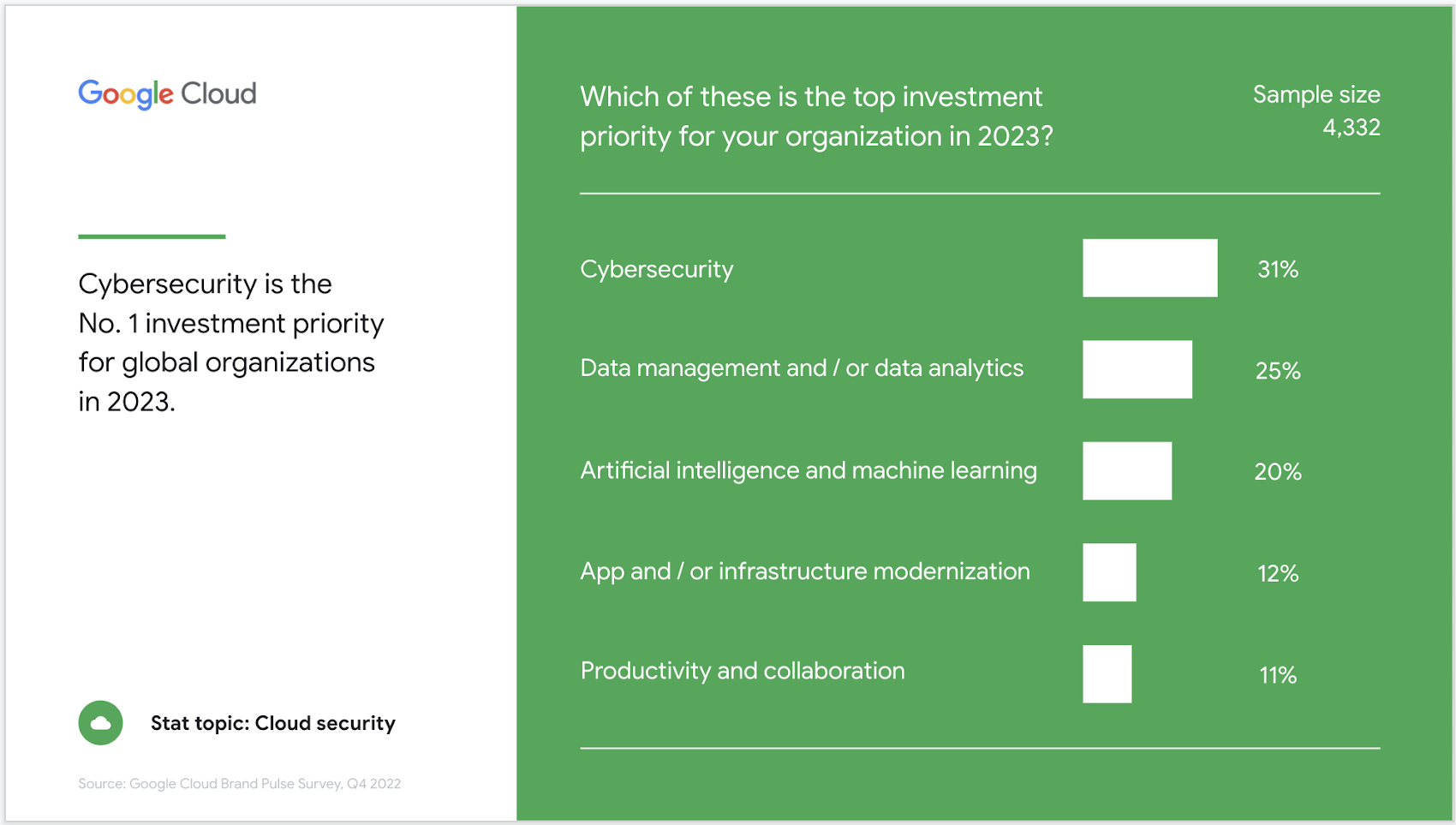

1. Cybersecurity is the No. 1 investment priority for organizations in 2023.
Approximately (31%) of 4,332 global enterprise cloud decision makers ranked “cybersecurity” as a top investment priority for their organization in 2023 over data management and/or data analytics (25%), AI&ML (20%), app and/or infrastructure modernization (12%), and productivity & collaboration (11%). Download slide Source: Google Cloud Brand Pulse Survey, Wave 5, 2022
2. When it comes to trusting a cloud provider, IT leaders say data protection and interoperability/openness are the two most important capabilities or provisions.
Globally, enterprise cloud decision makers feel that “strong capabilities for protecting and controlling my data in the cloud” (40%) and “working well with existing security solutions and other security vendors” (38%) are the top ways cloud providers can gain trust. Download slide Source: Google Cloud Brand Pulse Survey, Wave 5, 2022
3. Supply chains are growing as an attractive target that acts as an entry point to multiple vendors.
Supply chain was identified as the initial infection vector — the first path attackers used to gain access to an environment — in 17% of security intrusions in 2021, compared to less than 1% in 2020. Download slide Source: M-Trends 2022, Mandiant
4. Business and professional services and financial services are the top targeted industries across the globe.
The top five industries favored by adversaries in 2021, based on Mandiant incident response engagements, include business and professional services, financial, healthcare, retail and hospitality, and high tech. Download slide Source: M-Trends 2022, Mandiant
5. API security is affecting the pace of innovation for many organizations.
More than half (53%) of organizations have delayed the rollout of a new service or application due to API security concerns. For those who have experienced an incident in the past 12 months, more than three quarters (77%) have delayed the rollout of a new service or application. Download slide. Source: API Security: Latest Insights & Key Trends
6. Companies are prioritizing being proactive with API security.
To stay ahead of security threats, many organizations look for solutions that allow them to be proactive while minimizing the burden on their security teams. Capabilities that proactively identify security threats (60%) and improve automation (57%) are at the top of most IT leaders’ wish lists. Download slide. Source: API Security: Latest Insights & Key Trends
7. Development teams that embrace security see significant value driven to the business.
Teams who integrate security best practices throughout their development process are 1.6 times more likely to meet or exceed their organizational goals. Download slide Source: 2021 State of DevOps Report, commissioned by the Google Cloud DORA Team
8. The biggest predictor of an organization's software security practices is cultural, not technical.
High-trust, low-blame cultures focused on performance were 1.6 times more likely to have above-average adoption of emerging security practices than low-trust, high-blame cultures focused on power or rules. Download slide Source: 2022 State of DevOps Report, commissioned by the Google Cloud DORA Team
9. Europe may surpass the United States as the most targeted region for ransomware.
Ransomware continues to have a significant impact on businesses across the globe. While reports show that the U.S. is the country most targeted by ransomware attacks worldwide, small indicators show that ransomware activity is decreasing in the United States and growing in other regions. For instance, the number of European victims is on the rise, and if that increase continues, Europe will likely become the most targeted region in 2023. Download slide Source: Cybersecurity Forecast 2023, Mandiant
Corporate sustainability stats
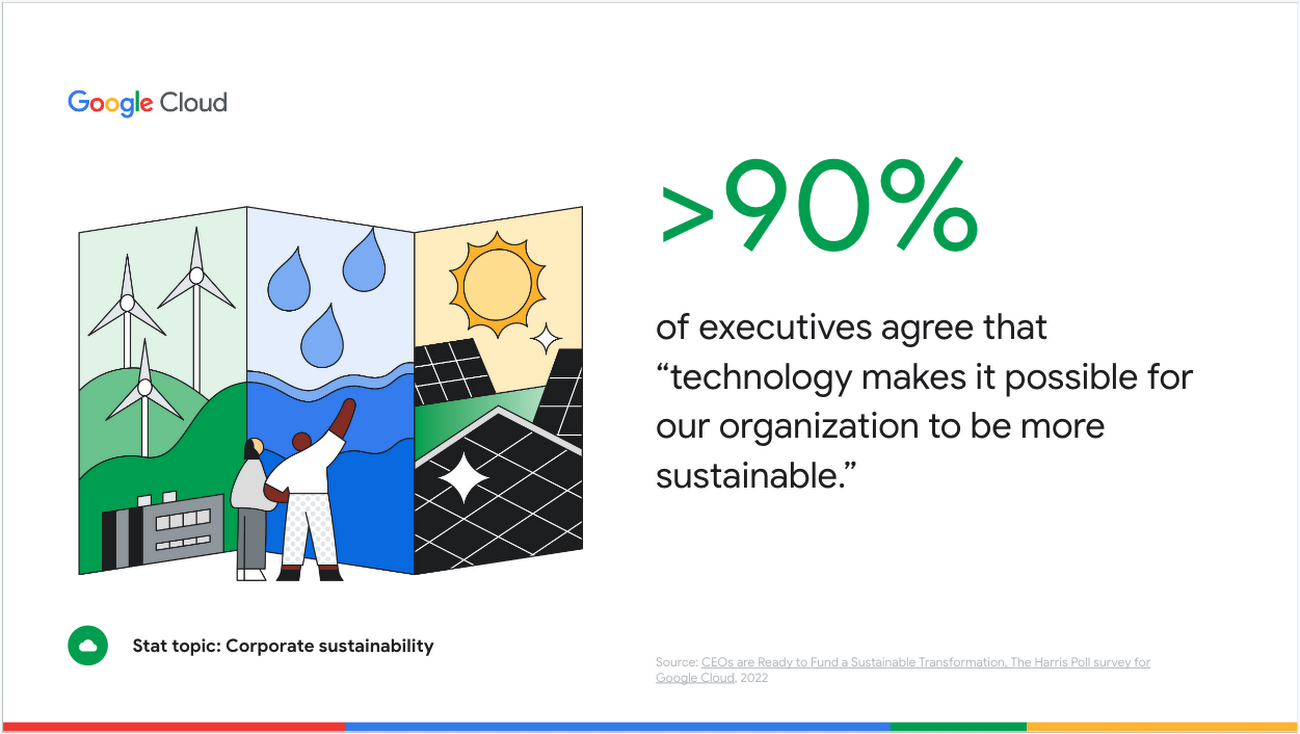

1. Technology innovation is the top utility executives believe will impact the sustainable growth of their organization.
More than 91% of respondents agree that “technology makes it possible for our organization to be more sustainable.” Download slide Source: CEOs are Ready to Fund a Sustainable Transformation, The Harris Poll survey for Google Cloud, 2022
2. Increasingly, sustainable technology will be a must-have; not a nice-to-have. By 2025, 50% of CIOs will have performance metrics tied to the sustainability of the IT organization.
Sustainable technology is a framework of digital solutions that can be used to enable ESG outcomes. Download slide Source: Gartner® ebook, Gartner's 2023 Top Strategic Technology Trends, 2022. GARTNER is a registered trademark and service mark of Gartner, Inc. and/or its affiliates in the U.S. and internationally and is used herein with permission. All rights reserved.
3. Many organizations still struggle to overcome internal barriers to achieving corporate sustainability.
When asked about the top barriers to achieving true environmental sustainability, executives identified the following as their biggest challenges: lack of investment in the right technology (36%), lack of understanding about the issue (36%), too much focus on growth and profit (34%), limited budget for sustainability measures (34%), and lack of regulatory incentives or political will (34%). Download slide Source: CEOs are Ready to Fund a Sustainable Transformation, The Harris Poll survey for Google Cloud, 2022
4. Digital technologies have the potential to help minimize carbon emissions across the entire digital value chain.
Digital solutions will play an enabling role for at least 20-25% of the reductions required to achieve a net-zero economy in Europe. Download slide Source: Digital Decarbonisation, Implement Consulting Group (ICG) study commissioned by Google, 2022
5. Digitalization is correlated with a higher degree of decoupling between economic growth and emissions.
The most advanced digital economies in the EU reduced greenhouse gas emissions by 25% between 2003 and 2019 while increasing economic output by 30% in the same period. Download slide Source: Digital Decarbonization, Implement Consulting Group (ICG) study commissioned by Google, 2022
6. Authentically achieving sustainability is a big challenge.
Only 36% of executives said that their organizations have measurement tools in place to quantify their sustainability efforts, and just 17% are using those measurements to optimize based on results. Download slide Source: CEOs are Ready to Fund a Sustainable Transformation, The Harris Poll survey for Google Cloud, 2022
7. Technology is key to transforming corporate sustainability.
Nearly 80% of executives cite technology as critical for their future sustainability efforts, attesting that it helps transform operations, socialize their initiatives more broadly, and measure and report on the impact of their efforts. Download slide Source: CEOs are Ready to Fund a Sustainable Transformation, The Harris Poll survey for Google Cloud, 2022



